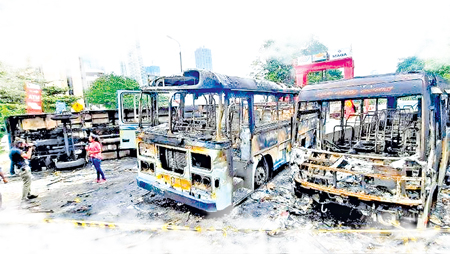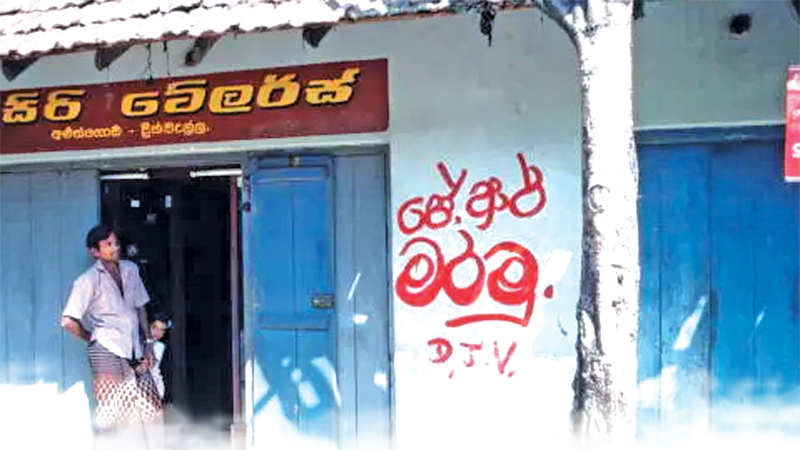It is often said that the Janatha Vimukthi Peramuna’s (JVP) support at ground level does not translate into votes at the polling booth. The 2014 Uva and Southern Provincial Council elections were a litmus test for this theory. The popularity of the Mahinda Rajapaksa Government was steadily declining, so much attention was paid to the opposition in the elections of these two provinces.
When the election results were received, JVP’s expectations were dashed. The United People’s Freedom Alliance (UPFA) won 47.37% of the total valid votes in Badulla district and won 09 seats and the United National Party won 44.79% and won 08 seats.
The JVP also showed great interest in Moneragala. But even from Moneragala, the JVP could get only 15,955 votes or 6.61% out of the total number of votes of 241,426 in the district. As a whole, the JVP got only 36,580 votes or 5.35% of the total number of 682,797 votes in the Uva province. In the 2014 Uva Provincial Council elections, the JVP was able to get only 5.3% of the votes. It was with this election result that showed the JVP’s ‘right place’ in the electoral landscape.
Election history
Today, the JVP is coming forward in another avatar as the ‘National People’s Power (NPP). The JVP is the only political party at national level in this political alliance. To get a rough idea of the current strength of the NPP, we have to analyse the JVP’s election history. The reason is that the ‘party vote base’ of any political party is ultimately decisive. For example, alliances with small parties and minority parties are needed to cross the threshold of 45%, which can be considered as the minimum percentage of votes required by any party to win an election and form a Government. But for a party with a voter base of less than 5% to come close to 45%, it has to increase its voter base by nine times or 900%. There are hardly any political parties in the democratic world that have achieved this kind of growth.
 As a party that was organised in 1970 to take over the state power through an armed struggle, the JVP first entered pro-democratic politics in the 1982 Presidential Election (PE). It was a good opportunity for JVP leader Rohana Wijeweera to get an understanding of his ‘true strength’. In the 1982 presidential election, when J.R. Jayewardene got 52.91% of votes, Sri Lanka Freedom Party (SLFP) candidate Hector Kobbekaduwa got 39.07% and JVP leader Rohana Wijeweera got 4.19% of votes. The JVP boycotted the 1988 PE and started their second armed struggle.
As a party that was organised in 1970 to take over the state power through an armed struggle, the JVP first entered pro-democratic politics in the 1982 Presidential Election (PE). It was a good opportunity for JVP leader Rohana Wijeweera to get an understanding of his ‘true strength’. In the 1982 presidential election, when J.R. Jayewardene got 52.91% of votes, Sri Lanka Freedom Party (SLFP) candidate Hector Kobbekaduwa got 39.07% and JVP leader Rohana Wijeweera got 4.19% of votes. The JVP boycotted the 1988 PE and started their second armed struggle.
In the fourth PE of 1999, when the JVP directly faced another PE after 1982, JVP candidate Nandana Gunathilaka could get only 344,173 votes or 4.08% of votes. In the 2005 PE, Mahinda Rajapaksa received the full support of the JVP. Likewise, it supported Sarath Fonseka in 2010 and Maithripala Sirisena in 2015. After 20 years, JVP contested a PE again in 2019.
In that very crucial election, when Gotabaya Rajapaksa got 52.25% and Sajith Preyamadasa got 41.99% of votes, Anura Kumara Dissanayake (AKD) got only 418,553 votes or 3.16%. Looking broadly at the history of elections from 1982 to 2019, we thus clearly see that their maximum voter base did not exceed 5% even if they presented themselves as JVP or as alliances.
Although JVP did not present candidates in five out of eight PEs due to various reasons, the percentage of votes obtained in the three elections in which they did appear is very small. According to the analysis of these results, JVP needs to increase its voter base which is 04% to approximately 50% and 10 times or 1000% to have some confidence or hope about the 2024 presidential election.
‘Democratic’ trend
A 1000% growth should be a ‘political wonder’ for a Left party.
The JVP is not a party that started to gain political power by believing in ‘Parliamentary democracy’, but a political party that started with the basic intention of acquiring or ‘usurping’ the political power of the capitalist class through an ‘armed struggle’. The JVP, which led two armed struggles in 1979 and 1986-90 to ‘seize’ the power of the state, has not yet made an ‘apology’ or at least a follow-up for the destruction caused by those two armed struggles, but they have entered the ‘democratic’ trend in the country.
Does the JVP or a political alliance led by the JVP have a real possibility of winning state power through an election? It is a problem that still exists today. Because in all the three presidential elections in which they stood, they had a voter base of about 4%. It is clear from the results of the 2014 Uva Provincial Council elections mentioned first in this article that this situation exists in the Parliament and the Provincial Council without ‘much change’.
The JVP, which contested the 11th General Election (GE) held on October 10, 2000, obtained 518,774 votes and claimed 10 seats. On that day, JVP got a percentage of 5.99% of the total votes. In the 12th GE held on December 5, 2001, after the collapse of the ‘probationary’ (Pariwasa) Government, the JVP got 815,353 votes, which is a percentage of 9.10% of the total votes. Here, JVP got 16 seats. The JVP, which won the highest number of votes, percentage and number of seats in its political history in the 2001 GE, contested the GE held on April 2, 2004 under the UPFA banner.
Alliance with SLFP
This decision is a decisive point in JVP politics because they entered into an alliance with the SLFP, a mainstream national political party, and contested the election under a broad front. In this case, the JVP, which ran an extremely thorough election campaign, was able to score top positions in Colombo, Gampaha and some other districts.
For example, when Wimal Weerawansa (237,185 votes), Sunil Handunnetti and Lakshman Nipunarachchi became the first three candidates in the Colombo district of the alliance, Vijitha Herath (215,540 votes) was the first winner of Gampaha district, Siripala Amarasingha was in the third place and Anjan Umma was in the fourth place. According to that, a total of 39 JVP candidates were elected to Parliament and the total number of seats they received was 41.
According to some political commentators, the surprising Parliamentary victory in 2004 brought ‘bad luck’ to the JVP and the loss of colorful and talented speakers to the party, as well as a breakdown in the admiration and confidence of the ‘common people’ towards the JVP.
In 2010, as expected, the JVP played politics with its political rival, the United National Party. After Sarath Fonseka’s defeat in the presidential election, the JVP contested the GE as the Democratic National Alliance. In this election, the DNA won 07 seats (with 02 national lists), with the JVP per se getting 03 seats. The JVP, which had won 39 seats in the general election held six years before, started its ‘collapse’ with the ‘opportunistic’ political spree in 2010.
The JVP supported Maithripala Sirisena at the 2015 PE but got only 4.87% vote percentage in the corresponding GE. In the February 2018 Local Government (LG) elections, the JVP got a vote percentage of 5.76%. The JVP again fell back to three seats in the 2019 GE. These three MPs are AKD, Vijitha Herath and Dr. Harini Amarasuriya.
From the 1982 PE to the 2019 PE, it is clear from the above analysis that in every election in which it has contested ‘alone’, it has failed to even exceed the minimum threshold of 5% of the total vote percentage. On that basis, if the JVP or the NPP is to achieve a growth of approximately 1000% in the next PE or GE, it will become a ‘political miracle’ and it will probably be a ‘litmus test’ for the electoral system that has been continuously practiced in Sri Lanka since 1931.









